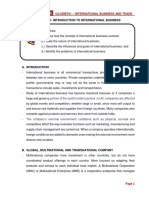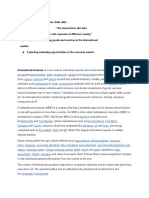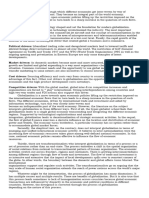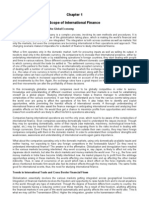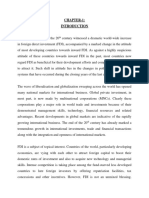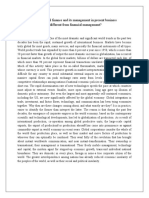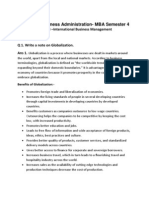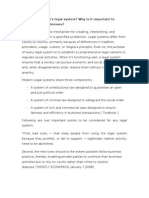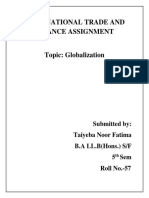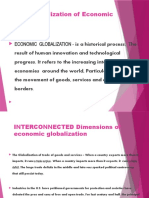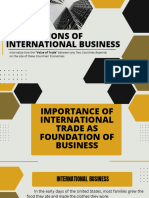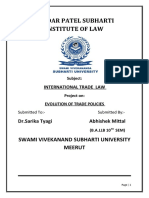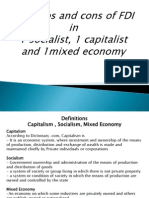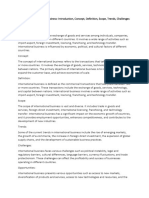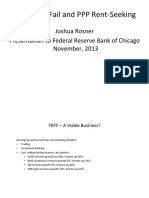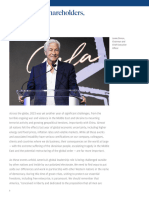Professional Documents
Culture Documents
Impact of Globalization
Impact of Globalization
Uploaded by
Laxman PatelOriginal Description:
Original Title
Copyright
Available Formats
Share this document
Did you find this document useful?
Is this content inappropriate?
Report this DocumentCopyright:
Available Formats
Impact of Globalization
Impact of Globalization
Uploaded by
Laxman PatelCopyright:
Available Formats
Impact of Globalization Positive impacts of Globalization
Globalization is the new catchphrase in the world economy, dominating the globe since the nineties of the last century. People relied more on the market economy, had more faith in private capital and resources, international organizations started playing a vital role in the development of developing countries. The impact of globalization has been fair enough on the developing economies to a certain extent. It brought along with it varied opportunities for the developing countries. It gave a fillip for better access to the developed markets. The technology transfer promised better productivity and thus improved standard of living. Negative impacts of Globalization
Globalization has also thrown open varied challenges such as inequality across and within different nations, volatility in financial market spurt open and there were worsening in the environmental situation. Another negative aspect of globalization was that a majority of third world countries stayed away from the entire limelight. Till the nineties, the process of globalization in the Indian economy had been guarded by trade, investment and financial barriers. Due to this, the liberalization process took time to hasten up. The pace of globalization did not start that smoothly. Economic integration by 'globalization' enabled the cross country free flow of information, ideas, technologies, goods, services, capital, finance and people. This cross border integration had different dimensions - cultural, social, political and economic. More or less the economic integration happened through four channels 1. 2. 3. 4. Trade in goods and services Movement of capital Flow of finance Movement of people
Advantages of globalization
The gains from globalization can be cited in the context of economic globalization:
Trade in Goods and Services - From the theoretical aspect, international trade ensures allocating different resources and that has to be consistent. This specialization in the processes leads to better productivity. We all know from the economic perspective that restrictive trade barriers in emerging economies only impede growth. Emerging economies can reap the benefits of international trade if only all the resources are utilized in full potential. This is where the importance of reducing the tariff and non-tariff barriers crop up.
Movement of Capital - The production base of a developing economy gets enhanced due to capital flows across countries. It was very much true in the 19th and 20th centuries. The mobility of capital only enabled savings for the entire globe and exhibited high investment potential. A country's economic growth doesn't, however, get barred by domestic savings. Foreign capital inflow does play an important role in the development of an economy. To be specific, capital flows either can take the form of foreign direct investment or portfolio investment. Developing countries would definitely prefer foreign direct investment because portfolio investment doesn't have a direct impact on the productive capacity expansion.
Financial Flows - The capital market development is one of the major features of the process of globalization. We all know that the growth in capital and mobility of the foreign exchange markets enabled better transfer of resources cross borders and by large the global foreign exchange markets improved. It is mandatory to go in for the expansion of foreign exchange markets and thus facilitate international transfer of capital. The major example of such international transfer of funds led to the financial crisis - which has by now become a worrying phenomenon.
Thus, globalization has the fair and rough share of its impacts and thus we can surely hope for more advancement in the global economy due to this process.
OPPORTUITIES AND THREATS FOR BRIC COUNTRIES
BRIC countries represent an important and unique business development & growth opportunity for companies having internationalization objectives. In any case, assessing opportunities and challenges in BRIC markets is useful exercise to any company. We believe that having business relationships in the BRIC markets is essential to successful companies, both to strengthen their position and to face real as well as potential competition. Very large territories, geographical distances, cultural differences and peculiarities in business habits make local presence a must. Operating through a traditional import-export model, handled by the domestic office of the company, does not enable a long-lasting and reliable business presence. BRIC countries are characterized by high growth rates. Therefore, companies are to build Curves of Experience fast, which is much easier with the help of expert consultants. Business Solutions is your ideal partner for BRIC countries, thanks to the close and priority collaboration with Competent Resident Partners. As a matter of fact we are able to help you in: - knowing these markets very well and in real-time; - freeing you of long, uncertain and expensive market researches; - supporting your first steps in an efficient and effective way; - arranging and assisting your business trips; - assisting in negotiations and deal structuring;
- identifying partners, distributors, agents, customers, resident managers, marketing and sales managers; - acting as problem-solvers in on-going business relationships; - assuring you a reliable and confidential local presence in BRIC countries; Business Solutions may be willing to link its compensation to actual results if and when in front of sound and dependable internationalization projects Download International Business BSOL- Brochure (PDF) For those who plan to set up business abroad, we have partnerships with local counterparts in Brazil, Russia, India and China. Our goal is to enable our clients to grow their business abroad, leveraging their core competence and competitive advantage. During the first BRIC summit last year, leaders from Brazil, Russia, India, and China discussed ways to conduct trade among themselves without using the U.S. dollar as a reserve currency. Russian President Dmitry Medvedev went so far as to unveil a new "world currency" coin at the G-8 meeting the following month to replace the dollar. At their second summit, held last month in Brazil, the BRIC countries acknowledged improvement in the world economy, but also noted the need for big changes. Finance and banking officials in the countries continue to look into regional monetary and trade arrangements. Could the BRIC countries threaten the dollar standard that the world has been operating on for decades? Why the dollar rules (for SEZ A Special Economic Zone (SEZ) is a geographical region that has economic and other laws that are more free-market-oriented than a country's typical or national laws. "Nationwide" laws may be suspended inside a special economic zone.
The category 'SEZ' covers a broad range of more specific zone types, including Free Trade Zones (FTZ), Export Processing Zones (EPZ),Free Zones (FZ), Industrial parks or Industrial Estates (IE), Free Ports, Urban Enterprise Zones and others. Usually the goal of a structure is to increase foreign direct investment by foreign investors, typically an international business or amultinational corporation (MNC). Histroy of Special Economic Zones (SEZ) The world first known instance of SEZ have been found in an industrial park set up in Puerto Rico in 1947. In the 1960s, Ireland and Taiwan followed suit, but in the 1980s China made the SEZs gain global currency with its largest SEZ being the metropolis of Shenzhen. From 1965 onwards, India experimented with the concept of such units in the form of Export Processing Zones (EPZ). But a revolution came in 2000, when Murlisone Maran, then Commerce Minister, made a tour to the southern provinces of China. After returning from the visit, he incorporated the SEZs into the Exim Policy of India. Five year later, SEZ Act (2005) was also introduced and in 2006 SEZ Rules were formulated. Salient features of SEZ The salient features of the Indian SEZ initiative further include the following points: 1. Unlike most of the international instances where zones are primarily developed by governments, the Indian SEZ policy provides for development of these zones in the government, private or joint sector. This is meant to offer equal opportunities to both Indian and international private developers. 1. 100 per cent FDI is permitted for all investments in SEZs, except for activities included in the negative list. 1. SEZ units are required to be positive net foreign-exchange earners and are not subject to any minimum value addition norms or export obligations. India is one of the first countries in Asia to recognize the effectiveness of the Export Processing Zone (EPZ) model in promoting exports. Asias first
EPZ was set up in Kandla in 1965. With a view to create an environment for achieving rapid growth in exports, a Special Economic Zone policy was announced in the Export and Import (EXIM) Policy 2000. Under this policy , one of the main features is that the designated duty free enclave to be treated as foreign territory only for trade operations and duties and tariffs. No licence required for import. The manufacturing, trading or service activities are allowed. The Ministry of Commerce and Industry lays down the regulations that govern the setting up and administering of the SEZs. The Central Government isfunctioning, while the State Governments play a significant lead role in the development of SEZs in their respective States by stipulating the conditions to be adhered to by an SEZ and granting the necessary approvals. The policy framework for SEZs has been enacted in the SEZ Act and the supporting procedures are laid down in SEZ Rules. In addition to the duty exemptions, the units in the Indian SEZs do not have to pay any income tax for the first five years and only pay half their tax liability for the next two. SEZ developers also enjoy a 10-year tax holiday. The size of an SEZ varies depending on the nature of the SEZ. At least 50 per cent of the area of multiproduct or sector specific SEZs must be used for export purposes. The rest can include malls, hotels, educational institutions, etc. Besides providing state-of-theart infrastructure and access to a large, well-trained and skilled workforce, the SEZ policy also provides enterprises and developers with a favourable and attractive range of incentives. Benefits of SEZ Apart from providing state-of-the-art infrastructure and access to a large well-trained and skilled work force, the SEZ also provides enterprises and developers with a favorable and attractive framework of incentives which include 100% income tax exemption for a period of five years and an additional 50% tax exemption for two years thereafter. Similarly, 100% FDI is also provided in the manufacturing sector. Exemption from industrial licensing requirements and no import license requirements is also given to the SEZ units. The area under SEZ covers a wide range of zones, including Export Processing Zones (EPZ), Free Zones (FZ), Industrial Estates (IE), Free Trade Zones (FTZ), Free Ports, Urban Enterprise Zones and others. Usually the
goal of an SEZ structure is to increase foreign investment in the country. At present there are fourteen functional SEZs located at Santa Cruz (Maharashtra), Cochin (Kerala), Kandla and Surat (Gujarat), Chennai (Tamil Nadu), Visakhapatnam (Andhra Pradesh), Falta and Salt Lake (West Bengal), Nodia (Uttar Pradesh), Indore (Madhya Pradesh), Jaipur (Rajasthan), etc. Attractive incentive and great investment opportunities have attractive many business tycoons to step into the SEZ all over the country. The first step was taken by the Mahindra World City at Chennai. The SEZ was promoted by Mahindra & Mahindra Ltd and later on by the Tamil Nadu Industrial Development Corporation. Mahindra & Mahindra Ltd holds 89% equity in the same. Later on, Reliance Industries also signed a pact with the Haryana government for setting up of the Rs. 25,000 crore multi products SEZ near Gurgaon in 2006. It is compulsory for every SEZ units in India to achieve positive net foreign exchange earning. For this particular purpose, a legal undertaking is required which has to be executed by a separate unit of the Development Commissioner. The is responsible for providing periodic reports to the Development Commissioner and Zone Customs State Governments play a very active role to play in the establishment of SEZ unit. Any proposal for setting up of SEZ unit in the Private / Joint / State Sector is routed through the concerned State government who in turn forwards the same to the Department of Commerce with its recommendations for consideration. Before recommending any proposals to the Ministry of Commerce & Industry (Department of Commerce), the States Government properly checks all the necessary inputs such as water, electricity, etc required for the establishment of SEZ units. The State Government has to forward the proposal with its recommendation within 45 days from the date of receipt of such proposal to the Board of Approval. The applicant also has the option to submit the proposal directly to the Board of Approval. Representative of the State Government, who is a member of the Inter-Ministerial Committee on private SEZ, is also consulted while considering the proposal.
I. Introduction The General Agreement on Tariffs and Trade (GATT), which was signed in 1947, is a multilateral agreement regulating trade among about 150 countries. According to its preamble, the purpose of the GATT is the "substantial reduction of tariffs and other trade barriers and the elimination of preferences, on a reciprocal and mutually advantageous basis." The GATT functioned de facto as an organization, conducting eight rounds of talks addressing various trade issues and resolving international trade disputes. The Uruguay Round, which was completed on December 15, 1993 after seven years of negotiations, resulted in an agreement among 117 countries (including the U.S.) to reduce trade barriers and to create more comprehensive and enforceable world trade rules. The agreement coming out of this round, the Final Act Embodying the Results of the Uruguay Round of Multilateral Trade Negotiations, was signed in April 1994. The Uruguay Round agreement was approved and implemented by the U.S. Congress in December 1994, and went into effect on January 1, 1995. WorldTradeLaw.net contains WTO negotiating history materials. This agreement also created the World Trade Organization (WTO), which came into being on January 1, 1995. The WTO implements the agreement, provides a forum for negotiating additional reductions of trade barriers and for settling policy disputes, and enforces trade rules. The WTO launched the ninth round of multilateral trade negotiations under the "Doha Development Agenda" (DDA or Doha Round) in 2001. "Doha Development Agenda: Negotiations, Implementation and Development" provides information about the Doha Round and links to texts that have been generated by the negotiations. GATT and WTO materials are available in the Goodson Law Library and in Perkins. The Davis Library at the University of North Carolina has been a depository library for GATT materials, and continues to receive most of the materials published by the WTO.
The General Agreement on Tariffs and Trade (typically abbreviated GATT) was negotiated during the UN Conference on Trade and Employment and was the outcome of the failure of negotiating governments to create the International Trade Organization (ITO). GATT was signed in 1947 and lasted until 1993, when it was replaced by the World Trade Organization in 1995. The original GATT text (GATT 1947) is still in effect under the WTO framework, subject to the modifications of GATT 1994.
Introduction There is no predefined definition of personal import. In general a personal import is a direct purchase of foreign goods from overseas mail order companies, retailers, manufacturers or by an individual for the purpose of personal use. The most common terms of purchase are as follows:
Consignment Purchase Cash-in-Advance (Pre-Payment) Down Payment Open Account Documentary Collections Letters of Credit
Consignment Purchase Consignment purchase terms can be the most beneficial method of payment for the importer. In this method of purchase, importer makes the payment only once the goods or imported items are sold to the end user. In case of no selling, the same item is returned to the foreign supplier. Consignment purchase is considered the most risky and time taking method of payment for the exporter. Cash-in-Advance (Pre-Payment) Cash in Advance is a pre-payment method in which, an importer the payment for the items to be imported in advance prior to the shipment of goods. The importer must trust that the supplier will ship the product on time and that the goods will be as advertised. Cash-in-Advance method of payment creates a lot of risk factors for the importers. However, this method of payment is inexpensive as it involves direct importer-exporter contact without commercial bank involvement. In international trade, Cash in Advance methods of payment is usually done when-
The Importer has not been long established. The Importer's credit status is doubtful or unsatisfactory. The country or political risks are very high in the importers country. The product is in heavy demand and the seller does not have to accommodate an Importer's financing request in order to sell the merchandise.
Down Payment In the method of down payment, an importer pays a fraction of the total amount of the items to be imported in advance. The down payment methods have both advantages and disadvantages. The advantage is that it induces the exporter or seller to begin performance without the importer or buyer paying the full agreed price in advance and the disadvantage is that there is a possibility the Seller or exporter may never deliver the goods even though it has the Buyer's down payment. Open Account In case of an open account, an importer takes the delivery of good and ensures the supplier to make the payment at some specific date in the future. Importer is also not required to issue any negotiable instrument evidencing his legal commitment to pay at the appointed time. This type of payment methods are mostly seen where when the importer/buyer has a strong credit history and is well-known to the seller. Open Account method of payment offers no protection in case of non-payment to the seller. There are many merits and demerits of open account terms. Under an open account payment method, title to the goods usually passes from the seller to the buyer prior to payment and subjects the seller to risk of default by the Buyer. Furthermore, there may be a time delay in payment, depending on how quickly documents are exchanged between Seller and Buyer. While this payment term involves the fewest restrictions and the lowest cost for the Buyer, it also presents the Seller with the highest degree of payment risk and is employed only between a Buyer and a Seller who have a long-term relationship involving a great level of mutual trust. Documentary Collections Documentary Collection is an important bank payment method under, which the sale transaction is settled by the bank through an exchange of documents. In this process the seller's instructs his bank to forwards documents related to the export of goods to the buyer's bank with a request to present these documents to the buyer for payment, indicating when and on what conditions these documents can be released to the buyer.
The buyer may obtain possession of goods and clear them through customs, if the buyer has the shipping documents such as original bill of lading, certificate of origin, etc. However, the documents are only given to the buyer after payment has been made ("Documents against Payment") or payment undertaking has been given - the buyer has accepted a bill of exchange issued by the seller and payable at a certain date in the future (maturity date) ("Documents against Acceptance"). Documentary Collections make easy import-export operations within low cost. But it does not provide same level of protection as the letter of credit as it does not involve any kind of bank guarantee like letter of credit. Letter of Credit A letter of credit is the most well known method of payment in international trade. Under an import letter of credit, importers bank guarantees to the supplier that the bank will pay mentioned amount in the agreement, once supplier or exporter meet the terms and conditions of the letter of credit. In this method of payment, plays an intermediary role to help complete the trade transaction. The bank deals only in documents and does not inspect the goods themselves. Letters of Credit are issued subject to the Uniforms Customs & Practice for Documentary Credits (UCPDC)(UCP). This set of rules is produced by the International Chamber of Commerce and Industries (CII). Documents Against Acceptance: Instructions given by an exporter to a bank that the documents attached to the draft for collection are deliverable to the drawee only against his or her acceptance of the draft.
Methods of Payment in International Trade To succeed in todays global marketplace, exporters must offer their customers attractive sales terms supported by the appropriate payment method to win sales against foreign competitors. As getting paid in full and on time is the primary goal for each export sale, an appropriate payment method must be chosen carefully to minimize the
payment risk while also accommodating the needs of the buyer. As shown below, there are four primary methods of payment for international transactions. During or before contract negotiations, it is advisable to consider which method in the diagram below is mutually desirable for you and your customer.
Cash-in-Advance With this payment method, the exporter can avoid credit risk, since payment is received prior to the transfer of ownership of the goods. Wire transfers and credit cards are the most commonly used cash-in-advance options available to exporters. However, requiring payment in advance is the least attractive option for the buyer, as this method creates cash flow problems. Foreign buyers are also concerned that the goods may not be sent if payment is made in advance. Thus, exporters that insist on this method of payment as their sole method of doing business may find themselves losing out to competitors who may be willing to offer more attractive payment terms. Letters of Credit Letters of credit (LCs) are among the most secure instruments available to international
traders. An LC is a commitment by a bank on behalf of the buyer that payment will be made to the exporter provided that the terms and conditions have been met, as verified through the presentation of all required documents. The buyer pays its bank to render this service. An LC is useful when reliable credit information about a foreign buyer is difficult to obtain, but you are satisfied with the creditworthiness of your buyers foreign bank. An LC also protects the buyer since no payment obligation arises until the goods have been shipped or delivered as promised. Documentary Collections A documentary collection is a transaction whereby the exporter entrusts the collection of a payment to the remitting bank (exporters bank), which sends documents to a collecting bank (importers bank), along with instructions for payment. Funds are received from the importer and remitted to the exporter through the banks involved in the collection in exchange for those documents. Documentary collections involve the use of a draft that requires the importer to pay the face amount either on sight (document against payment D/P) or on a specified date in the future (document against acceptanceD/A). The draft
lists instructions that specify the documents required for the transfer of title to the goods. Although banks do act as facilitators for their clients under collections, documentary collections offer no verification process and limited recourse in the event of nonpayment. Drafts are generally less expensive than letters of credit. Open Account An open account transaction means that the goods are shipped and delivered before payment is due, usually in 30 to 90 days. Obviously, this is the most advantageous option to the importer in cash flow and cost terms, but it is consequently the highest risk option for an exporter. Due to the intense competition for export markets, foreign buyers often press exporters for open account terms since the extension of credit by the seller to the buyer is more common abroad. Therefore, exporters who are reluctant to extend credit may face the possibility of the loss of the sale to their competitors. However, with the use of one or more of the appropriate trade finance techniques, such as export credit insurance, the exporter can offer open competitive account terms in the global market while substantially mitigating the risk of nonpayment by the foreign buyer.
Exim Policy
India has enormous opportunities emerging from globalization and consequent lowering of tariff barriers. Information Technology has given India formidable brand equity in the global markets. The Indian Software Industry has been moving up the value chain as well. Indian software companies have a unique distinction of providing efficient software solutions with cost and quality as an advantage by using state-of-the-art technology. Through joint efforts of Government and the Industry, Software Development and IT Enabled Services have emerged as niche opportunities for India in the global context. The Government has been making continuous efforts to make India a front-runner in the age of Information revolution. India today has the advantages of skilled manpower base, active and healthy competition amongst states in attracting investment in infrastructure as well as framing IT applications in areas such as e-governance, elearning, e-commerce, entrepreneurship, software exports growth and a large potential in the domestic market. Information Technology Act dealing with Cyber Security, Cyber Crime and other information security related legal aspects is in place. Through a policy of sustained R&D in cutting edge technology we hope to further increase and broad base our exports while also expanding the domestic market. India has the potential to develop and manufacture Electronics/IT Hardware for the global markets and gain higher global share besides meeting the country's future requirement in the converging areas of information, communication and entertainment. The Government has set up a National Manufacturing Competitiveness Council (NMCC) to provide a continuing forum for policy dialogue to energize and sustain the growth of manufacturing industry including IT hardware. As a result of technological convergence, at the infrastructure, services and industry level there has been a tremendous upsurge in new products and also consolidation in the underlying industries through acquisitions and mergers. Consequent shift has been from monopoly of Government as service provider to private
entry in telecom to promote competition and establishing a neutral regulatory agency. The essence of the convergence spirit and the vitality of changes have led to lowering of tariffs, plentiful availability of bandwidth at increasingly lower cost, competition and growth in technology, especially fibre optics and wireless technology. Internet is clearly surging ahead laying another milestone that promises to rewrite global and national economies. India has been successfully promoting reforms in all the constituents of the Internet, Communication and Entertainment sector. At the same time, our vision is to use Information Technology as a tool for raising the living standards of the common man and enriching their lives. Towards this end the Department of Information Technology has taken up an ambitious programme of PC and Internet penetration to the rural and under served urban areas. The Government of India's liberalization and economic reforms programme aims at rapid and substantial economic growth and integration with the global economy in a harmonized manner. The new policies have made governmental procedures transparent, eliminated licensing in almost all sectors and provide encouragement to entrepreneurship through market friendly systems. The Industrial Policy reforms have drastically reduced the industrial licensing requirements, removed restrictions on investment and expansion and facilitated easy access to foreign technology and foreign direct investment. An outward looking and liberal trade policy is one of the main features of India's economic reforms. In line with its mission of formulating a transparent investor friendly environment, the Government has done away with the complex pre-entry approvals. Foreign Direct Investment today can enter India in most sectors through the automatic route. India is a signatory to the Information Technology Agreement of the World Trade Organization and w.e.f. 1 st March, 2005 the customs duty on all the specified 217 items has been eliminated. Over the years, Foreign Trade Policy for Electronics and IT products has been liberalized, Customs and Excise procedures
simplified, EDI implemented by customs & under implementation by central excise and customs duty on specified capital goods and raw materials for electronics/IT hardware has been brought down to zero%. Electronics Hardware Technology Park (EHTP) and Special Economic Zones (SEZ) schemes have been tailored to boost manufacturing in the country.
(b) Chemicals and Pharmaceuticals : 1 2 3 drugs. (c) Projects: 1 more than one year. GROWTH ORIENTED (a) Strategic Package for Status Holders: 1 imports and exports on self-declaration basis. 2 per conditions notified by the RBI. 3 banks, However, the remittance would continue to be received through banking channels. 4 Currency 1EEFC) account. 5 cement in normal repatriation period from 180 days to 360 days,
(b) Diversification of Markets : 1 Indian exporters/businessmen... 2 of Indian export products. 3 2003. 4 Sub-Saharan African region. The exporters exporting to these markets shall be given Export House Status. on export of Rs. 5 crore. 5 be revived. (c) North Eastern States, Sikkim and Jammu and Kashmir : 1 d in North East, Sikkim and-Jammu and Kashmir so as to offset the disadvantage of being far from ports. (d)Neutralising High Fuel Cost:1 cost competitiveness of our export products. . PROCEDURAL REFORMS (a) Dgft: 1 the Director General of Foreign Trade (DGFT) would also be adopted bythe Customs and Director: General of Commercial Intelligence andStatistics (DGCI&S) shortly. This will eliminate the classification disputesand hence reduce transaction costs and time. 2 schemes has been reduced from Rs. 1.5 lakh to Rs. 1.00 lakh. 1 Same day licensing introduced in all regional offices. (b) Customs : 1 Adoption and harmonisation of the 8 digit Indian Trade Classification (ITC) Harmonised System (HS) code. 2 The percentage of physical examination of export cargo has already been reduced to less than 10% except for a few sensitive destinations. 3 Fixation of special brand rate of drawback within 15 days. (c) Banks : 1 Direct negotiation of export documents to be permitted. 2 100% retention in Exchange Earners Foreign Currency (EEFC)
accounts. 3 Enhancement in normal repatriation period from 180 days to 360 days.' TRUST BASED 1(a) Import and export of samples to be liberalised for encouraging product up gradation 2(b) Penal interest rate for bonafide defaults to be brought down from 24% to 15%. 3(c) No penalty for non-realisation of export proceeds in respect of cases covered. by ECGC insurance package. 4(d) No seizure of stock in trade so as to disrupt the manufacturing process affecting delivery schedule of exporters. 1(e) Foreign Inward Remittance Certificate (FIRC) to be accepted in lieu of Bank Realisation Certificate for documents negotiated directly. (f) Optional facility to convert from one scheme to another scheme. In case the exporter is denied the benefit under one scheme, he shall be entitled to claim benefit under some other scheme. (g) Newcomers. to be entitled for licences without any verification against execution of Bank Guarantee. DUTY NEUTRALISATION INSTRUMENTS 1(a) Advance Licence:-" 1 Duty Exemption Entitlement Certificate (DEEC) book to be abolished. Redemption on the basis of Shipping Bill and Bank Realisation Certificate. 2 Withdrawal of Advance Licence for Annual Requirement (AAL) scheme. The exporters can avail Advance Licence for any value. 1(b) Duty Entitlement Passbook (DEPB) Scheme : 1 Value cap exemption granted on 429 items to continue. 2 DEPB rates slashed on 8 out of 10 items. 3 Reduction in rates only after due notice. 4 No Present Market Value (PMV) verification except on specific intelligence' 5 Same DEPB rate for exports whether as CBUs or in CKD/SKD
form. . 6 DEPB for transport vehicles to Nepal in free foreign exchange. 1(c) Export Promotion Capital Goods (EPCG): 1 ave 12 year export obligation period with 5 year moratorium period. 2 years in respect of units in Agricultural Export Zones and in respect of companies under the revival plan of BIFR. . 3 pplies under Deemed Exports to be eligible for export obligation fulfilment along with deemed export benefit
http://www.scribd.com/doc/8823279/Export-Import-Policy
IMPLICATIONS OF THE EXIM POLICY 2002-07 The implications of the EXIM Policy 2002-07 are as follows : (a)All-round Development of Indian Economy:. The EXIM 2002-07emphasisesallround development of Indian economy by giving due weightageto different sectors of the economy. That is why. the policy has beendescribed as :1 2 3 4 5 6
7 agriculture, industry and services. 8 9 10 internationally competitive prices.
rvices at
You might also like
- IIBF Certified Credit Professionals 2018 PDFDocument277 pagesIIBF Certified Credit Professionals 2018 PDFRahul Kashyap75% (12)
- Approved Loan AgreementDocument2 pagesApproved Loan Agreementshaheda siddiqui100% (1)
- Careers in Commercial Banking Presentation - 210816-103043Document60 pagesCareers in Commercial Banking Presentation - 210816-103043Sangguniang Barangay Santa Maria, Santo Tomas CityNo ratings yet
- Chapter 1 - INTRODUCTION TO INTERNATIONAL BUSINESSDocument8 pagesChapter 1 - INTRODUCTION TO INTERNATIONAL BUSINESSCherrymae TangapanNo ratings yet
- Mary Elizabeth Croft - The Authority HoaxDocument9 pagesMary Elizabeth Croft - The Authority HoaxMichael KovachNo ratings yet
- Banking Laws - DizonDocument26 pagesBanking Laws - DizonZsa-shimi FranciscoNo ratings yet
- Ethical Analysis of The Financial CrisisDocument7 pagesEthical Analysis of The Financial Crisissir_vic2013No ratings yet
- Official G20 Business Summit PublicationDocument92 pagesOfficial G20 Business Summit PublicationChris AtkinsNo ratings yet
- Globalization: An Indian PerspectiveDocument10 pagesGlobalization: An Indian Perspectivesaurabh dixitNo ratings yet
- Foreign Trade PolicyDocument6 pagesForeign Trade PolicyvikysajwanNo ratings yet
- GlobalisationDocument5 pagesGlobalisationsabhirami34No ratings yet
- Globalization Globalization Has Become A Catchword in The New Millennium.Document22 pagesGlobalization Globalization Has Become A Catchword in The New Millennium.kediaprernaNo ratings yet
- 20190353-Assignment-1-Oct-22 2Document24 pages20190353-Assignment-1-Oct-22 2Dyani♥️✨No ratings yet
- Afu 08504 - International Finance - Introduction and The ImsDocument18 pagesAfu 08504 - International Finance - Introduction and The ImsAbdulkarim Hamisi KufakunogaNo ratings yet
- Capital Account Convertibility and IndiaDocument14 pagesCapital Account Convertibility and Indiadharit1710No ratings yet
- Impact of Globalization On Indian EconomyDocument18 pagesImpact of Globalization On Indian EconomybhavanaNo ratings yet
- International BusinessDocument27 pagesInternational BusinessRizsNo ratings yet
- Place Between The Citizens and Corporate of Different Country"Document10 pagesPlace Between The Citizens and Corporate of Different Country"Aswini K KrishnamurthiNo ratings yet
- Unit IDocument3 pagesUnit IUthra PandianNo ratings yet
- Foreign Direct Investment in MultiDocument13 pagesForeign Direct Investment in MultiPriya OberoiNo ratings yet
- International Business ManagementDocument96 pagesInternational Business ManagementA vyasNo ratings yet
- Afu 08504 - International Finance - Introduction and The ImsDocument18 pagesAfu 08504 - International Finance - Introduction and The ImsAbdulkarim Hamisi KufakunogaNo ratings yet
- Research Paper On International Trade in IndiaDocument8 pagesResearch Paper On International Trade in Indiapdtgpuplg100% (1)
- Bba 308Document55 pagesBba 308Mayur ViraniNo ratings yet
- Bba 308Document55 pagesBba 308Rohi KirigaNo ratings yet
- FINANCIAL MARKETS-ASSIGNMENT or ASSESSMENTDocument4 pagesFINANCIAL MARKETS-ASSIGNMENT or ASSESSMENTEvelyn LabhananNo ratings yet
- Siddiqui InternationalTradeWTO 2016Document28 pagesSiddiqui InternationalTradeWTO 2016Prince KatheweraNo ratings yet
- Internatoional Env ReportDocument21 pagesInternatoional Env ReportkomaljeswaniNo ratings yet
- Trade and Investment LawDocument23 pagesTrade and Investment LawVivek SaiNo ratings yet
- Globalization 094902Document5 pagesGlobalization 094902labutanrosabel0358No ratings yet
- Globalization and Development Revisited in The Light of Asian ExperienceDocument25 pagesGlobalization and Development Revisited in The Light of Asian ExperienceRobs TenefranciaNo ratings yet
- CH 1 - Scope of International FinanceDocument7 pagesCH 1 - Scope of International Financepritesh_baidya269100% (3)
- India Foriegn Trade PDFDocument76 pagesIndia Foriegn Trade PDFramana3339No ratings yet
- CBM 1st Exam Rev.Document9 pagesCBM 1st Exam Rev.Baby Leonor RazonableNo ratings yet
- CHAPTERDocument4 pagesCHAPTERabhaybittuNo ratings yet
- Attributes Growth To Good Economic and Investment PoliciesDocument6 pagesAttributes Growth To Good Economic and Investment PoliciespushpavathiNo ratings yet
- Introduction To International BusinessDocument5 pagesIntroduction To International BusinessrvdeepakNo ratings yet
- Drivers of International BusinessDocument4 pagesDrivers of International Businesskrkr_sharad67% (3)
- Bm318 Assignment 2Document9 pagesBm318 Assignment 2Mohd AdnanNo ratings yet
- For Mba Student Summer Assignment IfsDocument17 pagesFor Mba Student Summer Assignment IfsRajan ShrivastavaNo ratings yet
- Ab0cd: What Should The Multilateral Development Banks Do?Document27 pagesAb0cd: What Should The Multilateral Development Banks Do?Binu MalhotraNo ratings yet
- Lecture 3 - Introduction To International Business TradeDocument13 pagesLecture 3 - Introduction To International Business TradeCAMELLENo ratings yet
- 305-Int Fin-NotesDocument6 pages305-Int Fin-NotesRutik PatilNo ratings yet
- International Business: Photo By: Anton BalazhDocument3 pagesInternational Business: Photo By: Anton Balazhalina_97No ratings yet
- Master of Business Administration-MBA Semester 4: MB0053 - International Business ManagementDocument8 pagesMaster of Business Administration-MBA Semester 4: MB0053 - International Business ManagementDipika KumariNo ratings yet
- Impact of Globalization On Indian EconomyDocument32 pagesImpact of Globalization On Indian EconomyAbhijeet Kulshreshtha88% (25)
- Ifm Module 1Document9 pagesIfm Module 1Ramya GowdaNo ratings yet
- Bpos and KposDocument95 pagesBpos and KposZoya ShabbirhusainNo ratings yet
- Economics of International TradeDocument22 pagesEconomics of International TradeAyush Pratap SinghNo ratings yet
- What Is A CountryDocument7 pagesWhat Is A CountryKhushbu MehtaNo ratings yet
- Foreign Trade Policy 260214Document276 pagesForeign Trade Policy 260214vvgNo ratings yet
- International Trade and Finance Assignment: Submitted By: Taiyeba Noor Fatima B.A LL.B (Hons.) S/F 5 Sem Roll No.-57Document15 pagesInternational Trade and Finance Assignment: Submitted By: Taiyeba Noor Fatima B.A LL.B (Hons.) S/F 5 Sem Roll No.-57TaiyabaNo ratings yet
- Multinational Corporations (MNC'S) : Business OrganizationDocument42 pagesMultinational Corporations (MNC'S) : Business OrganizationAmit bailwalNo ratings yet
- IFM SyllabusDocument17 pagesIFM Syllabussagarzawar1No ratings yet
- Globalization of Economic RelationsDocument20 pagesGlobalization of Economic RelationsKristine OrtizNo ratings yet
- Lesson 1 IBT 2023Document25 pagesLesson 1 IBT 2023bryvinsarmientoNo ratings yet
- International Marketing Dec 2022 Vz6g3dDocument11 pagesInternational Marketing Dec 2022 Vz6g3dRajni KumariNo ratings yet
- International Tade LawDocument12 pagesInternational Tade Lawabhishek mittalNo ratings yet
- Industrialisation in IndiaDocument14 pagesIndustrialisation in Indiaabhi1211pNo ratings yet
- FDI, Foreign Direct InvestmentDocument20 pagesFDI, Foreign Direct InvestmentBhargesh VedNo ratings yet
- International Business Lecture 1Document13 pagesInternational Business Lecture 1Lillian KobusingyeNo ratings yet
- International Business Environment Mod 1Document5 pagesInternational Business Environment Mod 1ariyeah31141No ratings yet
- Q5. Does Globalization Impact National or Organization Culture Yes or No? Define With The Drive of Globalization. (20 Marks)Document8 pagesQ5. Does Globalization Impact National or Organization Culture Yes or No? Define With The Drive of Globalization. (20 Marks)neeleshNo ratings yet
- Responding To Globalization: India's AnswerDocument14 pagesResponding To Globalization: India's Answerneelesh_361497No ratings yet
- SAP Tables by ModuleDocument492 pagesSAP Tables by ModuleKarlo MarigzaNo ratings yet
- BAFS - Mock Paper 2A - Set 10 - EngDocument9 pagesBAFS - Mock Paper 2A - Set 10 - Enghannahho0723No ratings yet
- An Assessment of Financial Performance IDocument11 pagesAn Assessment of Financial Performance IMubarakNo ratings yet
- Annual Report 2007Document101 pagesAnnual Report 2007Farhat987No ratings yet
- Financial InstitutionsDocument54 pagesFinancial InstitutionsSukhwinder SinghNo ratings yet
- Financial Certification CoursesDocument15 pagesFinancial Certification CoursesMadhavi ReddyNo ratings yet
- NoteseDocument3 pagesNoteseJana Kryzl DibdibNo ratings yet
- Uk Visa Supporting LetterDocument6 pagesUk Visa Supporting LetterDaksh DhawanNo ratings yet
- 2013-11-14 Chicago Fed - Too Big To Fail & Infrastructure PPP Rent-SeekingDocument32 pages2013-11-14 Chicago Fed - Too Big To Fail & Infrastructure PPP Rent-SeekingJoshua RosnerNo ratings yet
- Final Full Thesis TextDocument79 pagesFinal Full Thesis TextLemlem TesfayeNo ratings yet
- CHAPTER SIX - Doc Internal Control Over CashDocument7 pagesCHAPTER SIX - Doc Internal Control Over CashYared DemissieNo ratings yet
- Muthyam Anusha, (18wj1e0044), Credit Risk ManagementDocument59 pagesMuthyam Anusha, (18wj1e0044), Credit Risk Managementaurorashiva1No ratings yet
- Building A Credit Risk ValuationDocument26 pagesBuilding A Credit Risk ValuationMazen AlbsharaNo ratings yet
- Career Opportunities of FinanceDocument5 pagesCareer Opportunities of FinanceMOHAMMAD SAIFUL ISLAMNo ratings yet
- E-Ticket 03YFZ0-SUMON ZYLDocument2 pagesE-Ticket 03YFZ0-SUMON ZYLMd.Kamrul HasanNo ratings yet
- FEDERAL BANK Financial Awareness QuestionsDocument7 pagesFEDERAL BANK Financial Awareness Questionsmathavan_00100% (1)
- Nordea's Digital StrategyDocument30 pagesNordea's Digital StrategyStanislav VazheninNo ratings yet
- Ceo Letter To Shareholders 2023Document60 pagesCeo Letter To Shareholders 2023TanayNo ratings yet
- Virgin Media Telecommunication Company EnglandDocument4 pagesVirgin Media Telecommunication Company EnglandmunashenickcNo ratings yet
- FIGL 322 Bank Reconciliation v07 PDFDocument92 pagesFIGL 322 Bank Reconciliation v07 PDFsandeep swamyNo ratings yet
- Form of Complaint With Banking OmbudsmanDocument3 pagesForm of Complaint With Banking OmbudsmanPranil NandeshwarNo ratings yet
- Unit 29 - GeetaDocument71 pagesUnit 29 - GeetaNabiha KhanNo ratings yet
- M/S Azad Trading Company: Below Jain Mandir, Lal Kuan BULANDSHAHR (U.P.) - 203001 Pan No - ABSPJ1368DDocument18 pagesM/S Azad Trading Company: Below Jain Mandir, Lal Kuan BULANDSHAHR (U.P.) - 203001 Pan No - ABSPJ1368DBhaveshNo ratings yet
- BudgetBrief2012 PDFDocument90 pagesBudgetBrief2012 PDFIdara Tehqiqat Imam Ahmad RazaNo ratings yet



